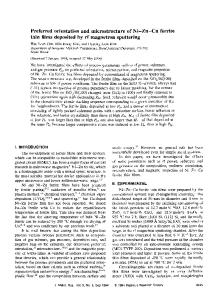RF Magnetron Sputtering Process for (Ba,Sr)TiO 3 Thin Films with Higher Dielectric Constant
- PDF / 634,864 Bytes
- 5 Pages / 612 x 792 pts (letter) Page_size
- 64 Downloads / 319 Views
C7.8.1
RF Magnetron Sputtering Process for (Ba,Sr)TiO3 Thin Films with Higher Dielectric Constant T. Jimbo, I. Kimura, Y. Nishioka and K. Suu Institute for Semiconductor Technologies, ULVAC, Inc., 1220-1 Suyama, Susono, Shizuoka 410-1231 Japan ABSTRACT (Ba,Sr)TiO3 (BST) films were deposited by RF magnetron sputtering using BST sintered ceramic targets and an approach to deposit BST films with higher permittivity by sputtering deposition was explored aiming to the application of thin film capacitor, RF tunable components and so on. Basic sputtering conditions such as RF power, deposition temperature and so on were varied in this study. BST films and Pt/BST/Pt capacitors were investigated by electrical properties, XRD analysis and SEM observation. It became clear that deposition temperature, deposition rate, and BST film thickness were important parameters for optimization of the dielectric constant. From the non-linearly relationship between dielectric constant and BST film thickness, we could also find that the interfacial layer between BST and Pt bottom electrode was important for controlling the BST film properties. Furthermore, an approach to enhance the crystalline quality has to be explored for further improvement of BST film properties. Dielectric constant could be raised up to 10% by just changing the gas flow sequence of BST sputtering process. INTRODUCTION In recent years, (Ba,Sr)TiO3 (BST) are expected to use as thin film capacitor, RF tunable components [1, 2], on-chip capacitor [3] for its excellent dielectric behavior. In these applications, decoupling, high permittivity and high tunability are required as dielectric characteristics. High permittivity is thought to be primarily important character as dielectric characteristics. Now, BST thin films have been deposited by some deposition techniques. Among these techniques, RF magnetron sputtering is thought to be suitable for mass-production because of its stability and reproducibility as well as good film performances [4]. In this study, BST films were deposited by RF magnetron sputtering and then an approach to deposit BST films with higher permittivity by sputtering deposition was explored. EXPERIMENTAL CONDITION BST films were deposited by RF magnetron sputtering method using sintered BST ceramic targets. As shown in Fig. 1, Cluster-type mass-production system SME-200 (ULVAC, Inc.) was used as a sputtering tool which have a special RF sputtering module for oxide materials such as BST, Pb(Zr,Ti)O3 (PZT), AlN, SiNx, Al2O3 and so on [5, 6]. Basic sputtering conditions such as RF power, deposition temperature and so on were varied. As a top
Fig. 1. SME-200, Cluster type massproduction system.
C7.8.2
electrode, Pt dot with 0.5 mm in diameter was deposited by DC magnetron sputtering. After top electrode deposition, BST capacitors were post-annealed for 1 hour in oxygen atmosphere under 1 atm using resistive heat furnace. Experimental conditions are summarized in Table I. Table I: Experimental condition BST Target Sintered ceramic (300 mmφ) RF power 500
Data Loading...










